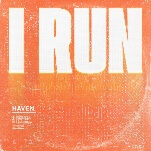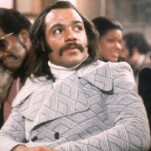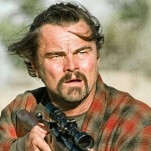AVC: The character of The Sampler is both a scientist and a musician, and the film seems to draw from both disciplines. How did you approach putting it together?
SC: It’s tough. The style sort of runs the gamut because we’re very precise and locked down at the beginning where the Thief comes in and puts Kris (Amy Seimetz) through this series of menial tasks. She’s completely being controlled in a really objective way—right there, it’s happening. Everything is stoic and locked down and precise. That’s all rigidly storyboarded. Most of it is storyboarded, but then sometimes we’ve got to get a little bit more experiential. When we’re talking about shared memories, it has to feel lyrical and homemade and intimate, so that means a whole other series of things to shoot. Those were the two ends of the spectrum, and I think we ran everything in between. The same thing with the edit: The rule isn’t only to do it by feel, but at some point if you’re going to go to that style, you have to let the editing match it as well.
AVC: There’s a moment where Kris is at work, and she’s watching stop-motion footage of what looks like a dinosaur made out of cardboard boxes. Is that from A Topiary?
SC: That is a creature from Topiary.
AVC: Was that just handy? How did that make its way into Upstream Color?
SC: That was one of the effects tests I was doing when I was trying to get that film made. I spent a lot of time building an effects workflow that could maintain an aesthetic I felt was important to the film and, at the same time, maybe be efficient financially so the film could get made. So the reality was she had to have a job, we had to show that she was a working girl—is it sexist to say “working girl”? I’m scared to death now—we had to show she had a job, and we had 20 or 30 seconds to show her at that job. I guess I thought that it was interesting to make her an effects person and show that clip. That’s all that comes down to. It’s sad because that’s all it is: clever. It isn’t anything meaningful.
AVC: It’s not a Rosetta Stone moment: “Ah, Kris represents you!”
SC: Oh, wow. No. Wow, I hope that’s not what happens.
AVC: The movie’s first section is deliberately disorienting, which mirrors Kris’ own confusion, but once she and your character meet, the love story puts the audience on more solid footing.
SC: That is definitely where we’re trying to get to, and the first third is mainly how we get there. The thing is, we have these characters who are going to be haunted by something that they can’t speak to. So we spend some time upfront on specifics, why she’s haunted and what it is that’s haunting her. So that’s, in really crass terms, the mechanical reason why that is there.
AVC: Your understanding changes as you watch. When Jeff, your character, tells Kris about his drug problem, it seems like a real-world analogy to what she’s gone through, but then you start to wonder if it’s a false memory, or if he’s just not telling her the whole truth because he doesn’t think she’d believe it.
SC: “I am lucky to have that job.” Both Kris and Jeff say that at different moments. I’m just very gratified to hear that part works.
AVC: And then it gets into the area of shared memory, which is more mysterious. Is this both of their lives, or some hybrid of them? Each third of the movie complicates, and to an extent overwrites, what came before.
SC: Well, the first third is setting up this architecture of how things work in this world. How do we get to a point where these characters are established as having these connections off screen? And then they meet and we have this, hopefully, personal, subjective experience as they contend with the fact that they’re being thrown together. Something is doing it, and they don’t necessarily want it. It doesn’t seem like they want it, but it’s happening. I really enjoy that. And then they get into this domestic situation. That’s life in the pig corral: Where do I end and where do you begin? That’s fusion and both the positives and negatives of that, both the intimacy… I had the right word for it the other day, but I can’t think of it. It’s like you don’t have your own identity, like you’re just half of something.
In this story, it sort of fuels this mania that exists, more for Kris than for Jeff. She’s haunted and certain there’s something to solve if only she can find the right direction to look. That middle third is a shift tonally, but that’s the heart of the story. The last third is a follow-through of everything we’ve seen and a resolution that is almost completely about subtext and nothing else. We’re only following will and motivation. It’s an emotional climax, a comedy of errors in some way; it’s Heart Of Darkness, going upriver and finding the culprit and doing him in. I’m sorry. All I’m doing now is describing the movie. But that last third is meant to be this almost-opera where everything is music and light and white space. It’s nondescript. There’s nothing left to talk about.
AVC: You decided in advance to self-distribute Upstream Color, and that means being involved at every step of the process, from choosing stills to cutting trailers to website design.
SC: That’s the sole reason to do this. It’s been really satisfying to contextualize and craft and frame the way the audience will see this. I think it’s really great. You can do more than just sell tickets, or raise awareness. It’s like this is the opening-credit sequence of the film. It sets the tone. There’s a way to approach this where you want to make as much money as possible. I get that. But I think if we’re willing to just have some integrity and some earnestness, we get to do something better and something we can be proud of. It’s a continuation of storytelling. When you’re writing a story, you can just write the bits that an author cares about or that I would care about: What’s the exploration? What’s the subtext? You can write it out, and it would be this dry, boring thing that may or may not be true, may or may not be important, but it’s certainly not compelling. And you can tell a story that has none of that stuff and it’s titillating moment by moment, but that’s pretty much worthless because what’s the point? So a narrative has to have both of these things. I’m already in the business of trying to be compelling and making a case for people to look at this thing, so I feel like I would like to try what’s called marketing, but it’s a continuation of storytelling. We’re getting to the film, and here’s… what, the preamble… What’s the word?
AVC: The overture?
SC: There we go. This is the overture. Wow, I’m using that from now on. Every time you see that reprinted, I stole it from you.
AVC: It’s not as if you’re just trying to be obscure. You look at some of the trailers and it’s, “Kissing! Guns! Axes!” I’m glad I didn’t watch them before I saw the film, but if I had, I would want to see that movie.
SC: There is commerciality in storytelling, even in a film or a piece of literature. These things exist. That’s why stories came to be: to hold attention and, while you’re not looking, you’ll get hopefully some nutritional value that the author has been working up. That’s narrative; that’s passing stuff down.
AVC: It’s interesting that the still image of a pitcher of ice water and a paperback book is obscure before you’ve seen the film, and very specifically meaningful once you have.
SC: That’s sort of the fun of it. Because if you put out three stills, and one of the stills is a water pitcher, it begs the question, “Why am I looking at a water pitcher?” ”Whose is this elbow and these legs that are offscreen, or almost offscreen?” And that’s storytelling as well. It’s like asking a question and if it’s a compelling enough question, maybe the audience will care enough to want to know the answer.
AVC: Part of your self-distribution is you’ve set a firm date for when the film will be available digitally and on DVD, which is not something that exhibitors are traditionally fond of. They don’t want audiences to skip buying the ticket because they’ll only have to wait a few weeks, or to have a film come out on video while it’s still doing well in theaters.
SC: There are theater chains that are like, “Nope. We’re not booking it if you’re going to do that.” And we have to be very open with them. And there are theaters that are okay with it. I can’t refute that it’s being self-distributed, but really, it’s just being distributed. Everything a distributor would do, we are doing. We are required to be a little bit craftier because we don’t have the resources and I’m not as savvy as them, but I think we make up for it in earnestness and staying true to the intent of the film. It’s a lot of work, but it’s a good thing.
AVC: Misrepresenting a film can only get you so far. Warner Bros. sold Steven Soderbergh’s Solaris as a George Clooney romance in space, which lasted until the first audiences saw the film and said, “What the hell is this?” You can sell it for a day by lying about what it is, but there will be blowback.
SC: Yeah. I’ve really paid attention to that in the last year, films that are not romantic comedies being sold as that. It’s like groupthink. It’s bureaucracy… okay, I’m not going to tear them down.
AVC: The entire movie industry?
SC: Whatever. It is what it is. I’m just glad this is a possibility now.
AVC: It’s interesting. There’s a structure in place and all these various windows of availability, but it’s hard to understand why in this day and age there’s several months between when a movie runs out of gas in theaters and when it’s available on DVD.
SC: It’s weird. There’s a lot of things like that, where it feels like they haven’t been thought about for a long time and that people are continuing to do them a certain way. There’s so many things that are breaking now, day-and-date stuff, movies are coming out on iTunes weeks before they’re available theatrically, and some of them are having success. It’s interesting.
AVC: It does seem like we’re in a prolonged “nobody knows anything” period about how media is going to connect with audiences.
SC: Yes! But I actually am very comforted by this. There’s more than enough on the table to do what you’re passionate about and keep moving forward. Don’t worry about are we moving to keep up and doing bigger and bigger things and get to a $200 million movie. I’m here to tell stories. I don’t know. Hopefully this works the way that is looks like it’s might work, and most of this is a repeatable process. I don’t have to keep moving up and try to make tens of millions of dollars. I’ve just got to sustain the ability to do this. Upstream Color in particular, it’s got to infect culture at some level in order to have a life of its own. Then it’ll be judged, and it’ll either live or it won’t by its own merit and history will decide whether it’s relevant however long into the future. I think that’s more than enough to hope for. You don’t need to build a studio or anything.
AVC: At Sundance, someone always asks what your budget was and what you shot on, but you don’t want to talk about what your camera setup was. Why is that?
SC: It’s because I don’t want the film to be characterized by these things. It’s weird that it becomes a topic of conversation—the camera, of all things. Nobody talks about what kind of audio gear we used. It’s like a spectator sport of some kind. I spent a lot of time trying to figure out the landscape of cameras, [especially] the new digital ones. With A Topiary, we were going to shoot on 65 mm, and I was really consumed with that and comparing resolutions and all these things. I just jettisoned all that. Now I only care about the narrative and an aesthetic that services it. As far as the tech of it, that’s like what accountant do I want to use, or who do I bank with. It’s just not part of the story.








































